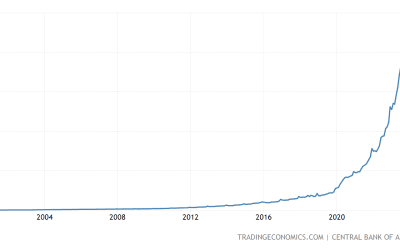Anyone who peruses my work on free banking—or my other writings for that matter—will notice that I’m not especially inclined to express my ideas mathematically. To put the matter more positively: I prefer plain English. The preference has if anything grown more marked over time. While writing Good Money, for example, I at one point let an equation slip into the first, expository chapter. But as soon as it occurred to me that a sentence would serve as well, while being a damn sight prettier to look at, out went the symbols. Likewise, when Liberty Fund decided to put The Theory of Free Banking in their Online Library of Liberty, I asked them to take out the few equations (and the one figure) found in the print version, as if they were so many blemishes (which, indeed, they were).
To resist using equations isn’t a strategy calculated to make life easy for an academic economist today. Yet it isn’t entirely for want of ability to do otherwise that I‘ve resorted to it. In fact I like math and was pretty darn good at it once upon a time. I just happen to think it wildly overrated as a means for “doing” economics—that is, for communicating ideas concerning how an economy works. For whatever its champions may think, mathematics is a language, and as such is a fit device for economic analysis only to the extent that the symbols it consists of are more capable of accurately conveying meaning than words themselves are. Of course mathematical expressions have their advantages: most obviously they tend to be less ambiguous than verbal ones; and it’s relatively easy to combine and manipulate bunches of them so as to ferret out implications or inconsistencies that might not otherwise be evident. Some ideas–Newton’s laws of motion naturally come to mind–can’t readily be stated at all, let alone figured out, using ordinary language. But math (by which I mean mainly algebra and calculus) has disadvantages also, the most obvious of which is that its limited grammatical repertoire simply doesn’t allow it to convey many subtleties of meaning of which properly-handled words are capable. Despite what some mathematical economists seem to suppose, it isn’t merely owing to a general lack of facility with algebra that people mainly communicate using words: it’s because you can say lots of things that way that you can’t possibly say with equations. Or maybe you can sort of say it with equations, but it’s dorky to even try.
Which brings me to free banking. Might greater resort to formal modeling enhance the theory? Of course it might. Like I said, equations can reveal things that mere words obscure. When Carl Christ reviewed The Theory of Free Banking for George Mason’s Market Process newsletter, he did so by writing down a formal model by which to examine my verbal reasoning. That reasoning was all O.K., according to Christ, except that his formal analysis made explicit an assumption that was only implicit in my own discussion, to wit: that by an increase in the volume of real activity I had in mind an increase in the number of transactions per period, rather than an increase in average transaction size. (In the former case reserve scale economies are realized, whereas in the latter they aren’t.) This is just the sort of thing math is good for, and it is why it’s worth trying to concoct formal models. Indeed, I later made Christ’s model the basis for one of my own, rare forays into mathematical economics, my 1994 paper “Free Banking and Monetary Control.”
On the other hand Christ’s review also convinced me that I was capable of doing reasonably “rigorous” economics using “mere” words; and I personally believe that, by making use of metaphors and other devices that have no exact mathematical counterparts (though equations are themselves metaphors of a sort), I added more to my theory’s intuitive appeal than I sacrificed in rigor.
The point is that both mathematical economics and the verbal kind have their place; neither is intrinsically better than the other; and each can serve as a useful test of the other. A formal model can reveal deficiencies or omissions in a verbal argument; but a few well-chosen words are just as capable of exposing an absurd argument or false assumption lurking in some seemingly innocent equation. The claim that “it takes a model to beat a model” would be just plain goofy were it not so effectively employed by mathematical economists anxious to insulate their work from criticisms by persons who know less math—but perhaps more economics—than they do.
Finally, I come to Larry Sechrest’s (1993) Free Banking, much of which is devoted to offering a formal interpretation of my own verbal theory. Larry’s book came up in comments on a previous post; and having made a brief remark upon it there I offered to expand upon it in light of a quick rereading. My recollection had been that Larry misinterpreted some of my arguments; in fact the misinterpretations are minor and are mainly confined to Larry’s own “verbal” exposition, as when he states (p. 14) that I argue “that a bank’s demand for reserves depends not only on the total volume of transactions but also on the frequency of those transactions.” (He presumably ought to have written “total volume of bank money outstanding and its turnover” or something like that.) But Larry’s formalization, unlike Carl Christ’s, contains no microeconomic refinements or revelations: it merely restates in symbols the comparative static conclusions I reach using words. If some find Larry’s approach more compelling (and it appears that some do), that’s lovely. But let’s not be guilty, as so many mathematical economists seem to be, of confusing a difference in rhetoric with a difference in rigor.




